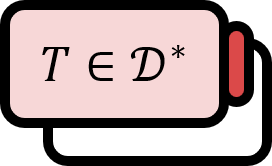Proof that the Dirac Delta Function is Not a Regularized Distribution
Theorem1
$$ \delta (\phi) := \phi (0), \quad \phi \in \mathcal{D} $$
As defined above, the Dirac delta function is not a regular distribution. Distributions that are not regular are called singular distributions.
Description
A regular distribution refers to a distribution that is defined with the existence of a locally integrable function $u$ as follows:
$$ T_{u}(\phi) := \int u(x) \phi (x) dx,\quad \phi \in \mathcal{D} $$
The statement that the Dirac delta function is not a regular distribution means that there is no locally integrable $u$ that satisfies the conditions below:
$$ \not\exists u\ \text{s.t. } \int u(x)\phi (x)dx = \delta (\phi) = \phi (0),\quad \phi \in \mathcal{D} $$
Proof
Proof by contradiction.
Let’s assume that there exists a locally integrable function $u$ that satisfies the following equation.
$$ \begin{equation} \int u(x)\phi (x)dx =\delta (\phi)=\phi (0),\quad \phi \in \mathcal{D} \label{eq1} \end{equation} $$
Now, consider the following test function.
$$ \begin{equation} \eta (x) =\begin{cases} e^{\frac{1}{x^{2}-1}} ,& \left| x \right| <1 \\ 0 & \left| x \right| \ge 1 \end{cases},\quad \eta_{m}(x)=\eta (mx)=\begin{cases} e^{\frac{1}{(mx)^{2}-1}} ,& \left| mx \right| <1 \\ 0 & \left| mx \right| \ge 1 \end{cases} ,\quad \forall m\in \mathbb{N} \label{eq2} \end{equation} $$
Then, the graph of $\eta _{m}$ is as follows.

Moreover, for all $m$, $\eta_{m}(0)=\eta (0)=e^{-1}$ is satisfied, and the support is $\mathrm{supp}\ \eta_{m}=[{\textstyle -\frac{1}{m}},{\textstyle \frac{1}{m}}]$. Therefore, the integral of $\eqref{eq1}$ can be written as follows.
$$ \begin{align*} \delta (\eta_{m})&=\int _{\mathbb{R}} u(x) \eta_{m}(x)dx \\ &=\int_{-{\textstyle \frac{1}{m}}}^{{\textstyle \frac{1}{m}}}u(x)\eta_{m}(x)dx \\ &=\eta_{m}(0) \\ &=e^{-1} \end{align*} $$
Taking the limit of $m \to \infty$ to the above equation gives the following.
$$ \begin{equation} \lim \limits_{m\to\infty} \int _{-{\textstyle \frac{1}{m}}}^{{\textstyle \frac{1}{m}}}u(x)\eta_{m}(x)dx =e^{-1} \label{eq3} \end{equation} $$
Also, considering $\eqref{eq2}$, the image of $\eta_{m}$ is $[0,e^{-1}]$. Therefore, $\eta_{m}$ is bounded by $e^{-1}$. By the condition that $u$ is also integrable, it is bounded by some $M>0$. Thus, the following holds.
$$ \begin{align*} \int_{-{\textstyle \frac{1}{m}}}^{{\textstyle \frac{1}{m}}}u(x)\eta_{m}(x)dx &= \int_{\mathbb{R}}\chi_{[-{\textstyle \frac{1}{m}},{\textstyle \frac{1}{m}}]}(x)u(x)\eta_{m}(x)dx \\ &\le \int_{\mathbb{R}}e^{-1}\left| \chi_{[-{\textstyle \frac{1}{m}},{\textstyle \frac{1}{m}}]}(x)u(x) \right|dx \\ &\le e^{-1}\frac{2}{m}M \end{align*} $$
Then, by the Dominated Convergence Theorem, the following equation holds.
$$ \begin{equation} \begin{aligned} \lim \limits_{m \to \infty} \int_{-{\textstyle \frac{1}{m}}}^{{\textstyle \frac{1}{m}}}u(x)\eta_{m}(x)dx &= \lim \limits_{m \to \infty} \int_{\mathbb{R}}\chi_{[-{\textstyle \frac{1}{m}},{\textstyle \frac{1}{m}}]}(x)u(x)\eta_{m}(x)dx \\ &= \int_{\mathbb{R}}\lim \limits_{m \to \infty}\chi_{[-{\textstyle \frac{1}{m}},{\textstyle \frac{1}{m}}]}(x)u(x)\eta_{m}(x)dx \\ & = 0 \end{aligned} \label{eq4} \end{equation} $$
$\eqref{eq3}$ and $\eqref{eq4}$ contradict each other, so we can conclude that the assumption was wrong. Therefore, the Dirac delta function is not a regular distribution.
■
Daniel Eceizabarrena perez, Distribution Theory and Fundamental Solutions of Differential Operators (2015), p5-6 ↩︎
